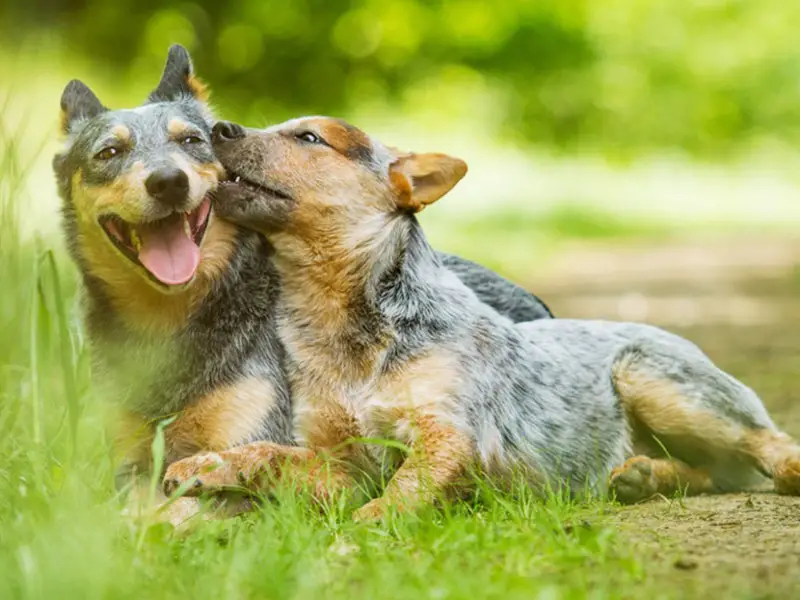It is always good to consider a dog’s friendliness with other dogs. Not only does this determine their overall temperament, but more importantly, it defines their social life as well. If you wonder how ACDs fare with other furry friends, you’ve come to the right place.
Australian Cattle Dogs were bred to herd cattle so they often like to take a dominant role in social situations and can be protective of their pack. With proper training and socialization, cattle dogs can be friendly and compatible with other dogs.

Cattle Dogs can become friendly with other canines over time. If you are planning to adopt an Australian Cattle Dog, here are some temperament-related behaviors you should consider.
Are Cattle Dogs Good with Other Dogs?
Cattle Dogs can be taught to be friendly with other dogs. Often, there were several Cattle Dogs on a ranch working together to control herds.
When in a pack, an ACDs strong instinct to herd may cause conflict or annoyance with other dogs. Outside of their pack, a Cattle Dog’s herding behavior towards other dogs can appear aggressive. When socializing with other dogs, they can try to be the boss and are generally single-minded as they focus on their need to heel other dogs.
Heelers’ dominant behavior becomes more prevalent with smaller or younger dogs. In some cases, cattle dogs may try to control the smaller dogs by herding using contact behaviors such as nipping at their heels.
However, they generally do not exhibit aggressive behavior toward smaller dogs unless they haven’t been properly socialized.
Are Cattle Dogs Good with Dogs of the Same Household?
Generally, cattle dogs are good with dogs of the same household; however, this is under the assumption that you take the right steps when introducing a new member of the family or when introducing the Heeler puppy to the family.
It is most important that you introduce your heeler to the household slowly and under supervision, especially if you have other dogs, pets, or younger kids. Because of their herding instinct, they may nip at the heels of family members if their new environment overstresses them.
Vice versa, if you plan to introduce a new pet or newborn to the family with a heeler already present, give your dog time to adapt. Do not suddenly allow the new member of your family to interact with the cattle dog for extended periods of time. Instead, let them get to know each other slowly.
Introduce the new pet or child as a playmate for your ACD, with increasingly more frequent playdates. Once these playdates become a common occurrence, you can be confident that your heeler is comfortable with all the members of your family.
A tip for smaller dogs… if you aim to have a heeler live with a smaller dog, it is optimal if the smaller dog is older in age. This offsets some of the dominant behavior that your heeler may exhibit.
How Can You Socialize Your Heeler?
After all, heelers, like any other dog, are social animals. They do enjoy the company of and socialization with other dogs. Because of their nature, however, it is essential to begin training and socialization from a very young age.
Socializing a Young Heeler
The best time to begin introducing your cattle dog to other dogs is between 8 to 12 weeks of age, after they have received their vaccinations.
Keep in mind, too much interaction can become an issue as well. Too much socialization may stress your heeler and may lead to different issues in the future. Give your ACD puppy time to adapt to different settings, environments, and companions.
The best way to socialize your Heeler is through habituation; the process of exposing him/her to different things on a regular basis so she/he becomes more accustomed to the world around them. Here are some ways to socialize your cattle dog:
- Expose your puppy to a variety of different objects. This can range from foods, to household items, and toys. A puppy is always curious and yearning to learn. They usually like to inspect everything around them.
- Expose your puppy to different textures. This includes, but is not limited to, carpets, tiling, grass, snow, cement, etc.
- Expose your puppy to travel. If they seldom travel in cars at a young age, they can be prone to carsickness when they get older.
- Expose your puppy to different types of people. Expose your puppy to people of different ages and characters. This allows them to experience and come to accept anybody and everybody. For example, a younger child may be more aggressive or excited when interacting with your Heeler, while a senior will be calmer.
- Most importantly, expose your puppy to other animals or pets. A good way to expose your Heeler puppy to other animals is through daycare, playdates, or classes. This gives them the opportunity to learn to interact with other animals, which will inevitably be a common occurrence in the future.
In order to make these interactions effective, remember by rewarding your puppy. By giving them physical treats or verbal praises, they learn that they are doing the correct behavior.
Socializing an Adult Heeler
Fair warning: socializing and training an adult heeler will take a lot more time and patience. The method, however, is the same as socializing a puppy. Your goal here is to help your Heeler build confidence through positive association and rewards for correct behaviors.
Final Thoughts
Although cattle dogs can be quite challenging to train and socialize with other dogs, it is far from impossible. With enough patience, determination and perseverance from both you and your dog, he/she can be the friendliest canine with other dogs and people. Allow your Cattle dog their own time and space when training. Sooner or later, socializing with other dogs will be a piece of cake!
